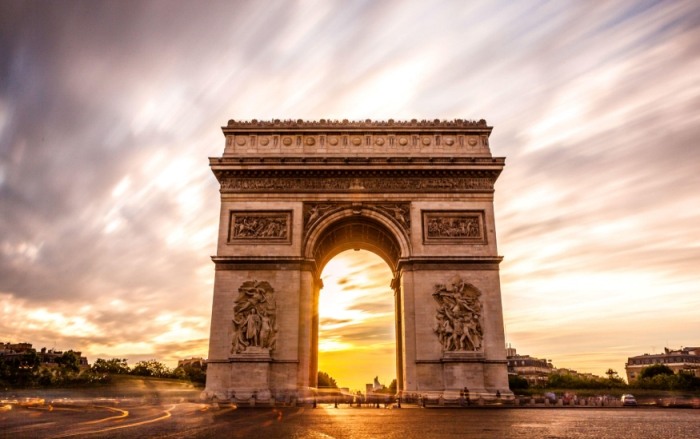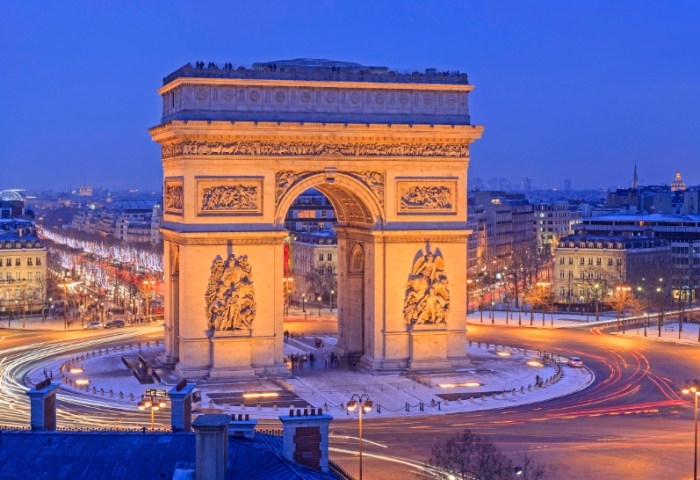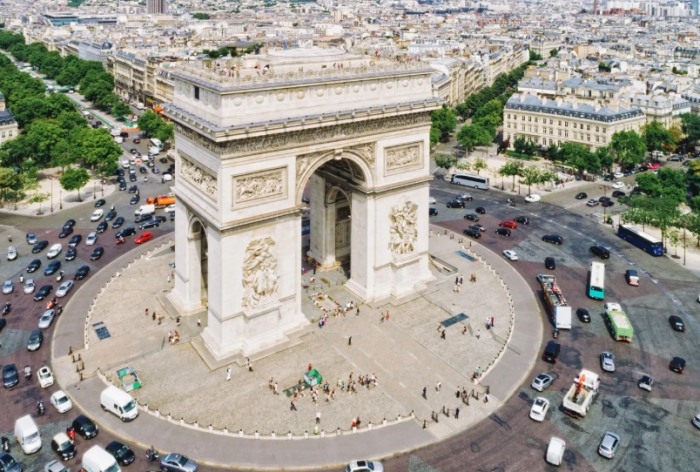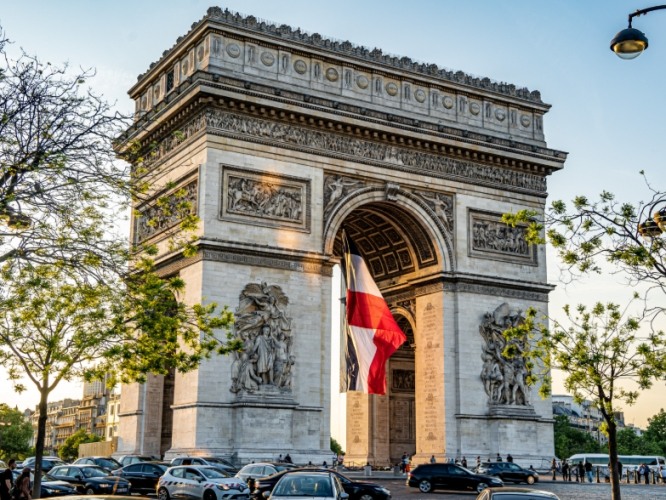Arc de Triomphe: The Symbol of French Victory & Napoleon's Legacy
Advertisements
Ever stood beneath the majestic Arc de Triomphe? Discover Napoleon's 1806 tribute to French military glory at Paris' iconic landmark—from its intricate reliefs honoring battles to the Tomb of the Unknown Soldier. Climb 284 steps for panoramic Champs-Élysées views, decode symbols like the winged Victory, and witness nightly flame ceremonies. Uncover secrets of its construction, historical parades, and role as the world’s largest roundabout!
Table of Contents
The Arc de Triomphe stands as an iconic symbol of France, a monumental arch that has witnessed centuries of history and continues to captivate visitors from around the globe. As a local resident of Paris, I have walked past this majestic structure countless times, each encounter offering a fresh perspective on its grandeur and significance. In this comprehensive guide, I will delve into the rich history, cultural importance, architectural beauty, and practical information that every traveler should know before visiting the Arc de Triomphe.
Historical Background

Origins and Construction
The Arc de Triomphe was commissioned by Napoleon Bonaparte in 1806 to commemorate his military victories. Designed by the architect Jean Chalgrin, the arch was inspired by the Roman Arch of Titus and symbolizes the triumph of the French army. Construction began the same year but was halted during Napoleon's exile and resumed only after his death. The monument was finally inaugurated in 1836 by King Louis-Philippe.
Historical Significance
The Arc de Triomphe has played a pivotal role in French history. It served as a backdrop for numerous military parades and national celebrations, including the annual Bastille Day parade. The Tomb of the Unknown Soldier, located beneath the arch, honors the unidentified soldiers who died during World War I. A perpetual flame, lit in 1923, burns in memory of the fallen, and a wreath-laying ceremony takes place every evening at 6:30 PM.
Notable Events
Over the years, the Arc de Triomphe has witnessed several significant events. In 1919, Charles Lindbergh flew his plane, the Spirit of St. Louis, under the arch upon his arrival in Paris after the first solo transatlantic flight. The arch has also been a focal point for political protests and demonstrations, reflecting its enduring relevance in French society.
Cultural Significance

Symbolism and National Identity
The Arc de Triomphe is more than just an architectural marvel; it is a powerful symbol of French national identity. It represents the nation's military prowess, historical achievements, and the collective memory of its people. The arch embodies the ideals of liberty, equality, and fraternity, values that are deeply ingrained in the French national consciousness.
Artistic and Architectural Influence
The design of the Arc de Triomphe has influenced numerous other arches and monuments worldwide. Its neoclassical style, characterized by its grandeur and symmetry, has become a hallmark of French architectural tradition. The intricate reliefs and sculptures adorning the arch depict scenes from French military history, adding to its artistic and cultural value.
Cultural Events and Festivals
The Arc de Triomphe is often the centerpiece of cultural events and festivals in Paris. During the annual Bastille Day celebrations, the arch is illuminated with patriotic colors, and a spectacular fireworks display lights up the night sky. The Tour de France, one of the world's most prestigious cycling races, traditionally concludes on the Champs-Élysées, with the Arc de Triomphe serving as the finish line.
Natural and Humanistic Landscapes

Surrounding Area
The Arc de Triomphe is located at the western end of the Champs-Élysées, one of the most famous avenues in the world. The area surrounding the arch is a vibrant blend of history, culture, and modernity. Visitors can explore the nearby Tuileries Garden, a beautiful public park that offers a peaceful retreat from the bustling city. The Place de l'Étoile, where the Arc de Triomphe stands, is a circular plaza surrounded by 12 radiating avenues, creating a star-like pattern that is both visually striking and architecturally significant.
Views and Vistas
One of the highlights of visiting the Arc de Triomphe is the panoramic view it offers of Paris. From the top of the arch, visitors can enjoy breathtaking vistas of the city's skyline, including the Eiffel Tower, the Sacré-Cœur Basilica, and the Seine River. The view is particularly stunning at sunset, when the golden light bathes the city in a warm glow.
Street Performers and Local Life
The area around the Arc de Triomphe is also a hub for street performers and local life. Musicians, artists, and entertainers often gather in the plaza, adding to the lively atmosphere. Visitors can take a break from sightseeing and enjoy a coffee or a snack at one of the many cafés and restaurants in the vicinity, soaking in the vibrant energy of the city.
Practical Information

Operating Hours
The Arc de Triomphe is open to the public year-round, with varying hours depending on the season. During the summer months (April to September), the arch is open from 10:00 AM to 11:00 PM. In the winter months (October to March), the hours are reduced to 10:00 AM to 10:30 PM. The arch is closed on January 1st, May 1st, and December 25th.
Ticket Prices
Admission to the Arc de Triomphe requires a ticket, which can be purchased on-site or online. The standard adult ticket costs €13, while reduced rates are available for students, seniors, and children under 18. Group rates and guided tours are also available for those interested in a more in-depth experience.
Transportation
The Arc de Triomphe is easily accessible by public transportation. The nearest metro station is Charles de Gaulle - Étoile, which is served by lines 1, 2, and 6. The RER A line also stops at this station, providing convenient access for visitors traveling from the suburbs. For those arriving by bus, several lines stop near the arch, including lines 22, 30, 31, 52, 73, and 92.
Best Time to Visit
The best time to visit the Arc de Triomphe depends on personal preferences. During the day, the arch is bustling with tourists, offering a lively atmosphere and the opportunity to explore the exhibits and view the city from above. However, for a more serene experience, consider visiting early in the morning or late in the afternoon, when the crowds are thinner. The evening hours, particularly during sunset, offer a magical ambiance, with the arch illuminated and the city lights twinkling below.
Special Features and Activities

Rooftop Access
One of the highlights of visiting the Arc de Triomphe is the opportunity to ascend to the rooftop and enjoy the panoramic views. A spiral staircase leads visitors up to the top, where they can explore the observation deck and take in the breathtaking vistas. The rooftop also features informational panels and exhibits that provide insight into the arch's history and significance.
Exhibits and Displays
Inside the Arc de Triomphe, visitors can explore a series of exhibits and displays that showcase the arch's history and cultural importance. The Museum of the Arc de Triomphe, located on the first floor, features artifacts, photographs, and documents that tell the story of the arch's construction and its role in French history. The Tomb of the Unknown Soldier, located beneath the arch, is a solemn and moving tribute to the fallen soldiers of World War I.
Guided Tours
For those interested in a more in-depth experience, guided tours of the Arc de Triomphe are available. These tours, led by knowledgeable guides, provide insight into the arch's history, architecture, and cultural significance. Guided tours are offered in multiple languages and can be booked in advance or on-site.
Special Events and Programs
Throughout the year, the Arc de Triomphe hosts a variety of special events and programs. These may include concerts, lectures, and workshops that explore different aspects of French history and culture. Check the official website or local tourism offices for information on upcoming events and programs.
Accommodation Recommendations
Luxury Hotels
For those seeking a luxurious stay near the Arc de Triomphe, several high-end hotels are located in the vicinity. The Hôtel Barrière Le Fouquet's, a five-star hotel located on the Champs-Élysées, offers elegant accommodations, world-class dining, and a prime location near the arch. The Four Seasons Hotel George V, another five-star property, is renowned for its opulent rooms, impeccable service, and stunning views of the city.
Mid-Range Hotels
For travelers on a budget, several mid-range hotels are available near the Arc de Triomphe. The Hôtel Champs-Élysées Friedland, a four-star hotel, offers comfortable rooms, a central location, and excellent value for money. The Hôtel du Collectionneur Arc de Triomphe, also a four-star property, features modern amenities, a stylish design, and a convenient location near the arch.
Budget-Friendly Options
For those looking for more affordable accommodations, several budget-friendly options are available near the Arc de Triomphe. The Hôtel Eiffel Kennedy, a three-star hotel, offers clean and comfortable rooms at a reasonable price. The Hôtel Le Relais Saint Charles, another three-star property, is located just a short walk from the arch and provides a convenient and affordable base for exploring the city.
Culinary Delights
Fine Dining
Paris is renowned for its culinary scene, and the area around the Arc de Triomphe is no exception. For a fine dining experience, consider visiting L'Atelier de Joël Robuchon, a Michelin-starred restaurant located near the arch. Known for its innovative cuisine and elegant ambiance, L'Atelier de Joël Robuchon offers a dining experience that is both memorable and indulgent. Another option is Le Jules Verne, a restaurant located on the second floor of the Eiffel Tower, which offers stunning views of the city and a menu that showcases the best of French cuisine.
Casual Dining
For a more casual dining experience, several restaurants and cafés are located near the Arc de Triomphe. Café de la Paix, a historic café located on the Place de l'Opéra, offers a classic French dining experience with a menu that features traditional dishes such as coq au vin and boeuf bourguignon. Brasserie Lipp, another iconic Parisian brasserie, is known for its hearty fare and lively atmosphere.
Street Food and Snacks
For those looking for a quick bite or a snack, the area around the Arc de Triomphe offers a variety of street food options. Creperies, where visitors can enjoy sweet or savory crepes, are a popular choice. Bakeries and patisseries, such as Ladurée and Pierre Hermé, offer a selection of pastries, macarons, and other sweet treats. For a more substantial snack, consider trying a falafel or a shawarma from one of the many Middle Eastern food stalls in the area.
Tips and Considerations
Safety and Security
While Paris is generally a safe city, it is always important to be aware of your surroundings and take precautions to ensure your safety. Avoid carrying large amounts of cash or valuable items, and be cautious of pickpockets in crowded areas. The area around the Arc de Triomphe can be particularly busy, so keep a close eye on your belongings and stay alert.
Weather and Clothing
Paris experiences a wide range of weather conditions throughout the year, so it is important to dress appropriately for the season. During the summer months, temperatures can be warm, so lightweight clothing and sunscreen are recommended. In the winter, temperatures can drop significantly, so warm clothing and a waterproof jacket are essential. Comfortable shoes are also a must, as there is a lot of walking involved in exploring the city.
Language and Communication
While many Parisians speak English, it is always helpful to learn a few basic French phrases before your trip. Simple greetings, thank-yous, and polite expressions can go a long way in making a positive impression and facilitating communication. Consider downloading a language translation app or carrying a pocket dictionary to help with any language barriers.
Etiquette and Customs
French culture places a strong emphasis on etiquette and politeness. When visiting the Arc de Triomphe or other cultural sites, it is important to dress appropriately and behave respectfully. Avoid loud conversations or disruptive behavior, and be mindful of other visitors. When dining out, it is customary to leave a small tip, usually around 10% of the bill.
Q&A
1. What is the Arc de Triomphe and why is it famous?
The Arc de Triomphe is a monumental arch located in Paris, France. It was commissioned by Napoleon Bonaparte in 1806 to commemorate his military victories and symbolize the triumph of the French army. The arch is famous for its historical significance, architectural beauty, and cultural importance. It has served as a backdrop for numerous military parades, national celebrations, and political events, and is a powerful symbol of French national identity.
2. Can tourists go up the Arc de Triomphe?
Yes, tourists can go up the Arc de Triomphe. A spiral staircase leads visitors to the rooftop, where they can enjoy panoramic views of Paris. The rooftop also features informational panels and exhibits that provide insight into the arch's history and significance.
3. Is it free to walk up the Arc de Triomphe?
No, it is not free to walk up the Arc de Triomphe. Admission to the arch requires a ticket, which can be purchased on-site or online. The standard adult ticket costs €13, while reduced rates are available for students, seniors, and children under 18.
4. Why did Napoleon make the Arc de Triomphe?
Napoleon Bonaparte commissioned the Arc de Triomphe in 1806 to commemorate his military victories and symbolize the triumph of the French army. The arch was designed to inspire national pride and serve as a lasting monument to France's military prowess. Construction began the same year but was halted during Napoleon's exile and resumed only after his death. The monument was finally inaugurated in 1836 by King Louis-Philippe.
In conclusion, the Arc de Triomphe is a must-visit destination for anyone traveling to Paris. Its rich history, cultural significance, architectural beauty, and breathtaking views make it a truly unforgettable experience. Whether you are a history buff, an architecture enthusiast, or simply looking to soak in the beauty of Paris, the Arc de Triomphe is sure to leave a lasting impression.
About the author:My name is Chloe, a lifelong Parisian with an insatiable passion for sharing the magic of la belle France. Through this blog, I’ll take you beyond the postcard clichés to uncover the soul of France—its riveting history, hidden-gem destinations, decadent cuisine, and the art de vivre that makes this country unforgettable. Whether you’re planning a trip, a foodie craving authentic recipes, or a culture enthusiast, join me as we explore everything from cobblestone villages to haute couture boutiques.
Advertisements